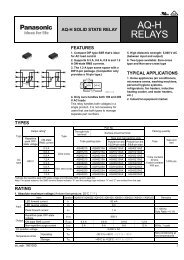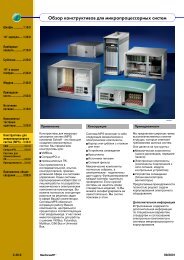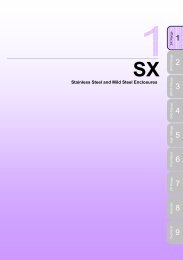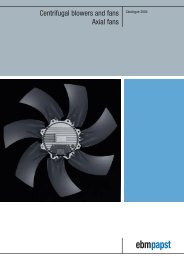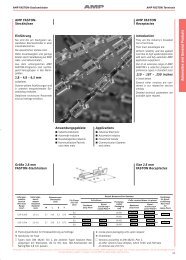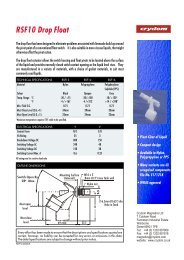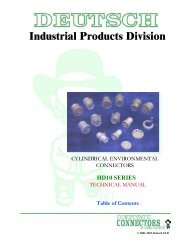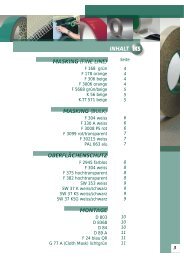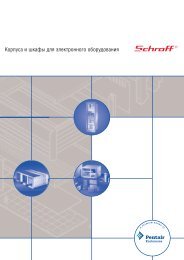Snap-Action Switches Detection Switches General Catalogue 2005
Snap-Action Switches Detection Switches General Catalogue 2005
Snap-Action Switches Detection Switches General Catalogue 2005
You also want an ePaper? Increase the reach of your titles
YUMPU automatically turns print PDFs into web optimized ePapers that Google loves.
NOTES<br />
1.Regarding fastening of switch body<br />
In fastening the switch body, use flat<br />
filister head M2.3 screws, with tightening<br />
torque of not more than 0.29N·m.To<br />
prevent loosening of the screws, it is<br />
recommended that spring washers be<br />
used with the screws and adhesive be<br />
applied to lock the screws.<br />
After mounting the switch and making<br />
wiring connectors, the insulation distance<br />
between ground and each terminal<br />
should be confirmed as sufficient.<br />
The positioning of the switch should be<br />
such that the pushbutton or actuator for<br />
the switch should not directly apply force<br />
to the operating section in the free<br />
condition.For a pushbutton, the force<br />
from the pushbutton should be applied in<br />
a perpendicular direction.<br />
In setting the movement after operation,<br />
the over-travel should be set not less<br />
than 70% as a standard.Setting the<br />
movement at less than 70% of O.T.may<br />
cause troubles such as mis-contact and<br />
welding due to small contact force of the<br />
switch.<br />
N.C.<br />
side<br />
Contact<br />
force<br />
N.O.<br />
side<br />
0<br />
P.T.<br />
70% of O.T.<br />
specified value<br />
Usable<br />
area<br />
O.T. spedified<br />
value<br />
O.T. max.<br />
Stroke<br />
2.Soldering operation<br />
For manual soldering: 60W soldering<br />
iron, soldering completed within 3<br />
seconds; do not apply force to the<br />
terminals.<br />
For automatic soldering tank: 250°C<br />
+482°F immersion, completed within 6<br />
seconds, 350°C +662°F immersion,<br />
completed within 3 seconds.<br />
Terminal portions must not be moved in<br />
min.1 minutes after soldering.Also no<br />
tensile strength of lead wires should be<br />
applied to terminals.<br />
3.Regarding connector connections<br />
(.110 quick connect terminals)<br />
For making connections, a dedicated<br />
receptacle for .110 quick connect<br />
terminals should be used, and the<br />
terminals should be inserted parallel to<br />
the receptacle.Consideration should be<br />
given to mounting so that no tensile load<br />
is applied to the lead wires.<br />
4.In making the switch selection<br />
Consideration should be given to provide<br />
for no interference up to +20% variation<br />
of the standard characteristics values.<br />
5.Environment<br />
Locations where corrosive gases having<br />
a bad influence on contacts are present,<br />
and locations where there is an<br />
excessive amount of siliceous or other<br />
abrasive dust should be avoided.<br />
AV3,AVM3/AVT3,AVL3<br />
6.Cautions regarding use<br />
This subminiatures switch has been<br />
designed as a dedicated switch for AC<br />
use, but it can be used for low capacity<br />
DC circuits.<br />
Please select gold-clad contact types<br />
when loads are in the low-level area of<br />
1mA up to 100mA and 5V up to 30V.<br />
3 A<br />
100 mA<br />
1 mA<br />
0<br />
DC<br />
AC<br />
5<br />
5<br />
For switching of inductive loads (relays,<br />
solenoids, buzzers, etc.), in order to<br />
prevent damage to contacts due to the<br />
occurrence of arcing, an arc absorbing<br />
circuit should be applied<br />
7.Quality check under Actual Loading<br />
Condition<br />
To assure reliability, check the switch<br />
under actual loading conditions.Avoid any<br />
situation that may adversely affect<br />
switching performance.<br />
8.When using lever type switch, care<br />
should be taken not to apply undue<br />
force on the body from the opposite<br />
side or side ways to its operating<br />
direction.<br />
Ag<br />
Au (-61)<br />
Triple layer contact type<br />
Au (-64)<br />
Double layer contac type<br />
15 30V<br />
30 250V<br />
91





